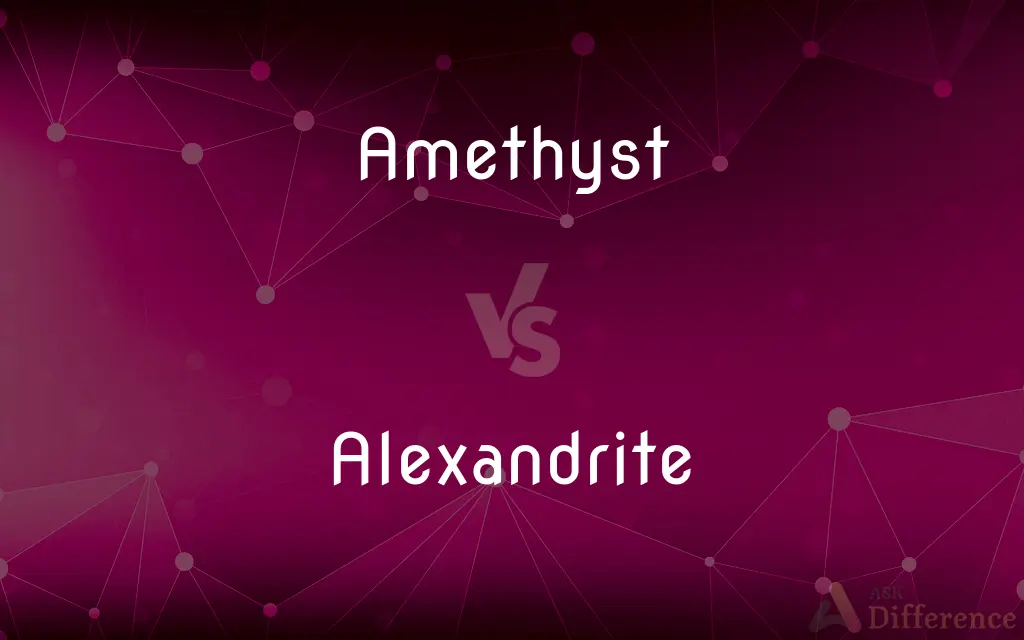Amethyst vs. Alexandrite — What's the Difference?
Edited by Tayyaba Rehman — By Fiza Rafique — Updated on September 24, 2023
Amethyst is a purple variety of quartz, while Alexandrite is a unique gemstone known for its color-changing property based on lighting.

Difference Between Amethyst and Alexandrite
Table of Contents
ADVERTISEMENT
Key Differences
Amethyst and Alexandrite are both captivating gemstones, each boasting its unique characteristics. Amethyst is primarily recognized for its rich purple hue, which stems from the quartz family. It's popularly used in various jewelry pieces due to its vibrant and transparent nature. On the other hand, Alexandrite is known for its rare ability to change color. This intriguing stone can appear green in daylight and transform to a red shade under incandescent light.
The history behind Amethyst is as rich as its color. Derived from the Greek word "amethystos," it translates to "not intoxicated," reflecting the ancient belief that the stone could prevent drunkenness. Meanwhile, Alexandrite was discovered in the Ural Mountains of Russia and named after Tsar Alexander II due to its unique colors, resembling the national military colors of imperial Russia.
Amethyst is more readily available and found in various locations worldwide, from Brazil to Zambia. It's a gemstone that has adorned royalty throughout history, symbolizing power and wealth. In contrast, Alexandrite, due to its rarity, is often more valuable. Originating from Russia, it can also be found in places like Brazil, Sri Lanka, and a few other locations.
Spiritually, Amethyst is often associated with properties like calmness, clarity, and spiritual growth. People believe that it can enhance intuition and spiritual wisdom. On the contrary, Alexandrite is considered a stone of prosperity and longevity. It's believed to bolster self-esteem and the ability to experience joy.
To summarize, while both Amethyst and Alexandrite are treasured gemstones, their differences lie in color, historical significance, availability, and believed spiritual properties. Amethyst's defining feature is its purple hue, and Alexandrite's unique charm lies in its chameleon-like color-changing ability.
ADVERTISEMENT
Comparison Chart
Color
Purple
Changes (green in daylight to red in artificial light)
Mineral Group
Quartz
Chrysoberyl
Historical Significance
Symbol of power; prevents intoxication
Named after Tsar Alexander II; Russian military colors
Availability
More common
Rare and often more valuable
Spiritual Associations
Calmness, clarity, spiritual growth
Prosperity, longevity, joy
Compare with Definitions
Amethyst
Often associated with spiritual properties.
She wore an Amethyst pendant for calmness.
Alexandrite
A gemstone known for color-changing properties.
In sunlight, the Alexandrite appeared green, but it turned red under a lamp.
Amethyst
Derived from the Greek word "amethystos."
The word Amethyst suggests a protection against intoxication.
Alexandrite
Part of the Chrysoberyl mineral group.
Among the Chrysoberyl family, Alexandrite stands out due to its unique characteristics.
Amethyst
Found in multiple global locations.
Brazilian Amethyst has gained considerable popularity in recent years.
Alexandrite
Rare and often more valuable than many other stones.
Due to its scarcity, Alexandrite often fetches a high price in the market.
Amethyst
A purple-colored quartz gemstone.
The ring was adorned with a stunning Amethyst.
Alexandrite
Named after Tsar Alexander II of Russia.
Alexandrite was discovered around the time of Tsar Alexander II's coming of age.
Amethyst
Amethyst is a violet variety of quartz. The name comes from the Koine Greek αμέθυστος amethystos from α- a-, "not" and μεθύσκω (Ancient Greek) methysko / μεθώ metho (Modern Greek), "intoxicate", a reference to the belief that the stone protected its owner from drunkenness.
Alexandrite
Often associated with prosperity and longevity.
Wearing Alexandrite is believed to bring about good fortune.
Amethyst
A precious stone consisting of a violet or purple variety of quartz
Amethyst earrings
A delicate necklace of amethysts and pearls
Alexandrite
A greenish chrysoberyl that appears red in artificial light, used as a gemstone.
Amethyst
A purple or violet form of transparent quartz used as a gemstone.
Alexandrite
(mineral) A form of chrysoberyl that displays a colour change dependent upon the light source, along with strong pleochroism.
Amethyst
A purple variety of corundum used as a gemstone.
Alexandrite
A green variety of chrysoberyl used as a gemstone
Amethyst
A moderate purple to grayish reddish purple.
Amethyst
A transparent purple variety of quartz, used as a gemstone.
Amethyst
(uncountable) A purple colour.
Amethyst
(tincture) The tincture purpure, when emblazoning the arms of the English nobility.
Amethyst
Having a colour similar to that of the gemstone
Amethyst
A variety of crystallized quartz, of a purple or bluish violet color, of different shades. It is much used as a jeweler's stone.
Amethyst
A purple color in a nobleman's escutcheon, or coat of arms.
Amethyst
A transparent purple variety of quartz; used as a gemstone
Amethyst
Of a moderate purple color
Amethyst
Historically, a symbol of power and wealth.
Kings and queens favored Amethyst in their crowns.
Common Curiosities
What color is Amethyst?
Amethyst is recognized for its purple hue.
What does the name Amethyst signify?
Amethyst, derived from "amethystos," means "not intoxicated" in Greek.
Which gemstone changes color based on lighting?
Alexandrite changes color, appearing green in daylight and red in incandescent light.
Which stone is rarer and often more valuable?
Alexandrite, due to its unique properties and rarity, is often more valuable.
Why is Alexandrite associated with Russian military colors?
Alexandrite's color change from green to red resembles the national military colors of imperial Russia.
Who was Alexandrite named after?
Alexandrite was named after Tsar Alexander II of Russia.
Which gemstone is believed to provide calmness and clarity?
Amethyst is often associated with calmness, clarity, and spiritual growth.
Which gemstone was favored by royalty for power?
Amethyst has historically been a symbol of power and wealth, adorned by royalty.
What are the spiritual properties associated with Alexandrite?
Alexandrite is believed to bring prosperity, longevity, and joy.
Which stone is believed to prevent intoxication?
Amethyst was historically believed to prevent intoxication.
Is Alexandrite part of the quartz family?
No, Alexandrite belongs to the Chrysoberyl mineral group.
Are there any other gemstones that change color like Alexandrite?
While Alexandrite is famous for its dramatic color change, some other gemstones exhibit color-change properties, though not as pronounced.
Is Alexandrite commonly found worldwide?
Alexandrite is rare, with primary sources originally in Russia but also found in Brazil, Sri Lanka, and a few other places.
Where can you commonly find Amethyst?
Amethyst is found in various locations globally, including Brazil, Uruguay, and Zambia.
Can both gemstones be used in jewelry?
Yes, both Amethyst and Alexandrite are popular choices for various jewelry pieces.
Share Your Discovery

Previous Comparison
Flourish vs. Prosper
Next Comparison
Monohybrid vs. DihybridAuthor Spotlight
Written by
Fiza RafiqueFiza Rafique is a skilled content writer at AskDifference.com, where she meticulously refines and enhances written pieces. Drawing from her vast editorial expertise, Fiza ensures clarity, accuracy, and precision in every article. Passionate about language, she continually seeks to elevate the quality of content for readers worldwide.
Edited by
Tayyaba RehmanTayyaba Rehman is a distinguished writer, currently serving as a primary contributor to askdifference.com. As a researcher in semantics and etymology, Tayyaba's passion for the complexity of languages and their distinctions has found a perfect home on the platform. Tayyaba delves into the intricacies of language, distinguishing between commonly confused words and phrases, thereby providing clarity for readers worldwide.
















































